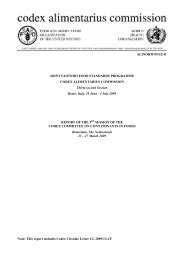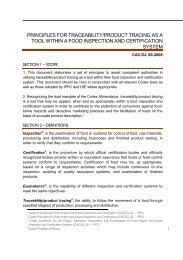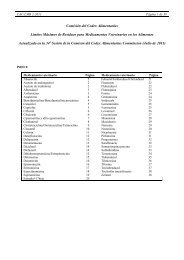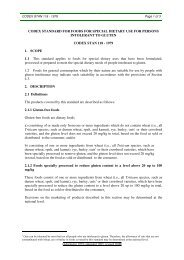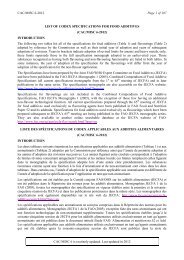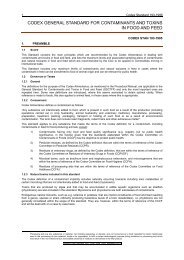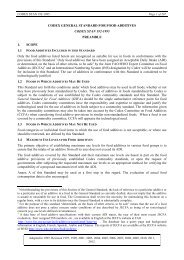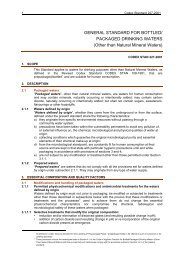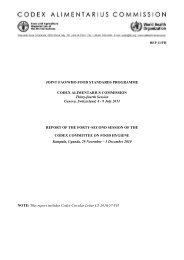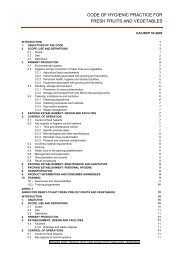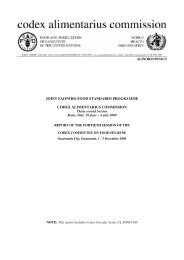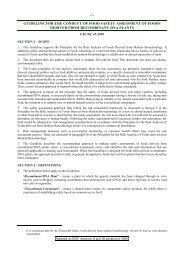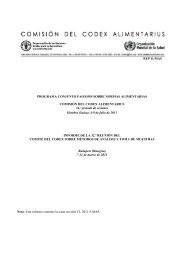proposed draft guidelines for the validation of food safety control
proposed draft guidelines for the validation of food safety control
proposed draft guidelines for the validation of food safety control
Create successful ePaper yourself
Turn your PDF publications into a flip-book with our unique Google optimized e-Paper software.
CAC/GL 69 - 2008 Page 4 <strong>of</strong> 16<br />
c) Identify <strong>the</strong> measures that are to be validated, taking into account:<br />
• The importance <strong>of</strong> <strong>the</strong> <strong>control</strong> measure in achieving <strong>control</strong> <strong>of</strong> <strong>the</strong> hazard to a specified<br />
outcome. Examples might include:<br />
o Heat treatment step in a canning process<br />
o Cooling to a specified temperature within a specific timeframe<br />
• Whe<strong>the</strong>r <strong>the</strong> <strong>control</strong> measure has already been validated<br />
Identify whe<strong>the</strong>r <strong>the</strong> <strong>control</strong> measure has previously been validated in a way that is applicable and<br />
appropriate to <strong>the</strong> <strong>food</strong> business (e.g. a <strong>control</strong> measure required by a competent authority or<br />
validated by a competent authority or o<strong>the</strong>r national or international organization) or whe<strong>the</strong>r its<br />
per<strong>for</strong>mance is so well established <strong>for</strong> <strong>the</strong> application under consideration that fur<strong>the</strong>r <strong>validation</strong> is<br />
not necessary. In ei<strong>the</strong>r case, a <strong>food</strong> business operator must ensure that <strong>the</strong> conditions (e.g. raw<br />
materials, relevant hazards, combinations <strong>of</strong> <strong>control</strong> measures, intended use, and distribution and<br />
consumption patterns) in <strong>the</strong>ir particular operation do not differ from <strong>the</strong> conditions under which <strong>the</strong><br />
<strong>control</strong> measure was previously validated.<br />
• Priority <strong>of</strong> <strong>validation</strong><br />
Considering that <strong>food</strong> <strong>safety</strong> outcomes are <strong>of</strong>ten dependent on multiple <strong>control</strong> measures,<br />
prioritization <strong>of</strong> <strong>validation</strong> activities may be necessary and may take into account:<br />
o Adverse health effect: The higher <strong>the</strong> potential <strong>for</strong> an adverse health effect from a<br />
hazard, <strong>the</strong> more attention should be paid to assuring that <strong>the</strong> set <strong>of</strong> <strong>control</strong> measures<br />
selected is effective. Consideration should be given to <strong>the</strong> size <strong>of</strong> <strong>the</strong> population and <strong>the</strong><br />
age/sex <strong>of</strong> groups most at risk.<br />
o Historical experience: For many <strong>food</strong> production and processing scenarios, <strong>the</strong>re is<br />
extensive history that specific measures used to <strong>control</strong> <strong>food</strong> borne hazards are<br />
effective. If little or no experience exists with respect to <strong>the</strong> per<strong>for</strong>mance <strong>of</strong> a <strong>control</strong><br />
measure in <strong>control</strong>ling a particular hazard within a specified context, it becomes more<br />
important that <strong>validation</strong> be undertaken.<br />
In certain instances, <strong>the</strong>se historical data may obviate <strong>the</strong> need to conduct <strong>validation</strong>s.<br />
However, it is important to avoid assuming that a <strong>food</strong> production or processing system<br />
is safe based solely on historical experience. All relevant current in<strong>for</strong>mation should be<br />
considered when evaluating <strong>the</strong> adequacy <strong>of</strong> historical in<strong>for</strong>mation, as it may be<br />
outdated. For example, sampling and testing procedures used to obtain <strong>the</strong> original data<br />
may be insufficient in <strong>the</strong> context <strong>of</strong> current operating procedures. New strains <strong>of</strong><br />
microbial pathogens may now exist that do not behave in <strong>the</strong> same manner as <strong>the</strong> strains<br />
<strong>of</strong> pathogens or surrogate microorganisms used <strong>for</strong> determining early <strong>food</strong> <strong>control</strong><br />
processes. New epidemiological and/or clinical in<strong>for</strong>mation may indicate that <strong>the</strong><br />
<strong>control</strong> measures used in <strong>the</strong> past were less effective than previously thought.<br />
o O<strong>the</strong>r factors/constraints<br />
Ability to monitor and verify <strong>the</strong> <strong>control</strong> measure<br />
• In prioritizing <strong>control</strong> measures <strong>for</strong> <strong>validation</strong>, consideration should be<br />
given to <strong>the</strong> amenability <strong>of</strong> <strong>the</strong> <strong>control</strong> measure to monitoring and/or<br />
verification after implementation.



